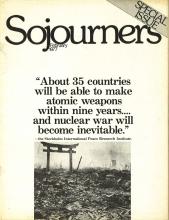In August of 1945, an American B-29 bomber, the Enola Gay, dropped the first atom bomb on the Japanese city of Hiroshima. That day marked a great leap forward in the science of military annihilation. Until then, the most destructive weapon which could be dropped from the air was the block buster, a bomb equivalent to about ten tons of dynamite. The atom bomb initiated a whole new principle with the “fission,” or splitting, of a heavy atom, such as uranium or man-made plutonium. The new bomb had a destructive capacity equivalent to from 1300 to 2000 blockbusters, and it completely destroyed a city of 300,000 people.
By 1976, according to Ruth Legar Sivard, former chief economist of the Arms Control and Disarmament Agency, the United States possessed “a nuclear stockpile of 8,000 megatons” (i.e. 8,000 million tons of dynamite equivalent). That is equal to 615,385 bombs like the atom bomb dropped on Hiroshima, which immediately killed 78,000 people, injured 84,000 and demolished 62,000 buildings. “Using the Hiroshima analogy,” says Sivard, “the nuclear stockpile of the United States alone translates into a potential kill-power 12 times the present world population.”
The rest of the world, mainly the Soviets, possess another 8,000 megatons of nuclear warheads, and the United States continues to produce nuclear weapons at the rate of three new ones each day. Sidney Lens, who has written extensively on the nuclear threat, warns us that “humanity is at the threshold of still another ‘new era’ in which the ‘peaceful’ use of the atom for electrical energy will make it possible within the next few years for dozens of nations--not to mention terrorist gangs--to fabricate their own atom bombs. What was once the monopoly of one country, then of two, three, and six, threatens to become the property of almost every tin-horn dictator and opportunist on the globe.”
Read the Full Article

